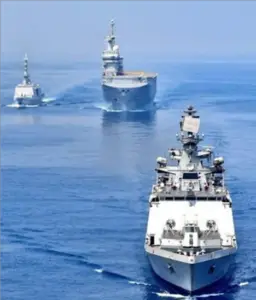
why in news?
- India’s naval prowess takes a formidable leap forward with the unveiling of INS Tushil, the latest addition to its maritime fleet.
- Setting sail on its sea trials from Russia’s Baltiysk naval base, INS Tushil embodies the culmination of strategic defense partnerships and indigenous naval capabilities.
The Creation of INS Tushil
- INS Tushil represents the first Krivak-III frigate procured under Project 11356M.
- This initiative, stemming from an Inter-Governmental Agreement (IGA) signed between India and Russia in October 2016, aims to acquire four Admiral Grigorovich-class frigates.
- While Russia provides two frigates, including INS Tushil, India is tasked with constructing the remaining two domestically.
Project 11356M: A Strategic Collaboration
- The genesis of Project 11356M signifies a strategic collaboration between India and Russia in naval modernization.
- Designed to enhance India’s maritime defense capabilities, these frigates, also known as Talwar-class vessels, are equipped to meet the multifaceted challenges of modern naval warfare.
Technological Advancements
- This boasts an array of advanced features designed to bolster its combat effectiveness. Stealth technology ensures minimal radar and underwater noise signatures, enhancing its survivability in hostile environments.
- The integration of Indian and Russian-supplied weaponry, including surface-to-surface missiles, sonar systems, and anti-submarine warfare suites, underscores its versatility and lethality on the high seas.
Operational Capabilities:
- Equipped to engage both surface and subsurface threats, INS Tushil is primed for a spectrum of naval operations.
- Its robust construction, with a displacement of 3620 tons and a cruising range of 4850 miles, ensures endurance and agility across diverse maritime environments.
- With a top speed of 30 knots, it can swiftly maneuver through contested waters, asserting India’s maritime presence with authority.
India’s Maritime Strategy
- INS Tushil’s induction into the Indian Navy aligns with India’s broader maritime strategy, which emphasizes security, stability, and prosperity in the Indian Ocean region.
- As a key player in the Indo-Pacific theater, India seeks to safeguard vital sea lanes, counter emerging threats, and promote regional cooperation through collaborative defense initiatives.
A Testament to Bilateral Cooperation
- INS Tushil stands as a testament to the enduring defense partnership between India and Russia.
- Through technology transfer, joint ventures, and collaborative procurement programs, both nations continue to strengthen their defense capabilities while fostering mutual trust and strategic alignment.
Conclusion
- INS Tushil epitomizes India’s commitment to maritime dominance and security in an increasingly complex geopolitical landscape.
- As it embarks on its sea trials, INS Tushil heralds a new chapter in India’s naval history, underscoring its resolve to protect its maritime interests and contribute to global peace and stability.
- In the evolving paradigm of maritime security, INS Tushil emerges as a beacon of strength, resilience, and strategic foresight, poised to navigate the high seas with confidence and resolve.
People also ask
Q1: What is INS Tushil?
Ans: It is India’s latest naval asset, a Krivak-III frigate acquired under Project 11356M, aimed at bolstering India’s maritime defense capabilities.
Q2: What is Project 11356M?
Ans: Project 11356M involves an Inter-Governmental Agreement (IGA) between India and Russia to purchase/construct four Admiral Grigorovich-class frigates. Two frigates, including INS Tushil, are supplied by Russia, while the other two will be constructed in India.
Q3: What are the key features of INS Tushil?
Ans: It incorporates stealth technology for low radar and underwater noise signatures. It is equipped with a range of Indian and Russian-supplied weaponry, including surface-to-surface missiles, sonar systems, surveillance radar, and anti-submarine warfare systems.
Q4: What are the combat capabilities of INS Tushil?
Ans: It is designed to engage submarines, warships, and aerial threats independently and within naval formations. With a displacement of 3620 tons, a top speed of 30 knots, and a cruising range of 4850 miles, it demonstrates agility and endurance in various maritime operations
Thanks for sharing. I read many of your blog posts, cool, your blog is very good.
Can you be more specific about the content of your article? After reading it, I still have some doubts. Hope you can help me.
Thanks, Ample posts.
casino en ligne
Incredible a lot of terrific data.
casino en ligne
Great data. Kudos.
casino en ligne
Amazing write ups, Thanks a lot!
casino en ligne
You actually said it perfectly!
casino en ligne
You actually suggested it superbly.
casino en ligne
Regards. A lot of advice!
casino en ligne
Cheers, I like it.
casino en ligne
Kudos, Plenty of postings.
casino en ligne
Nicely put, Kudos.
meilleur casino en ligne